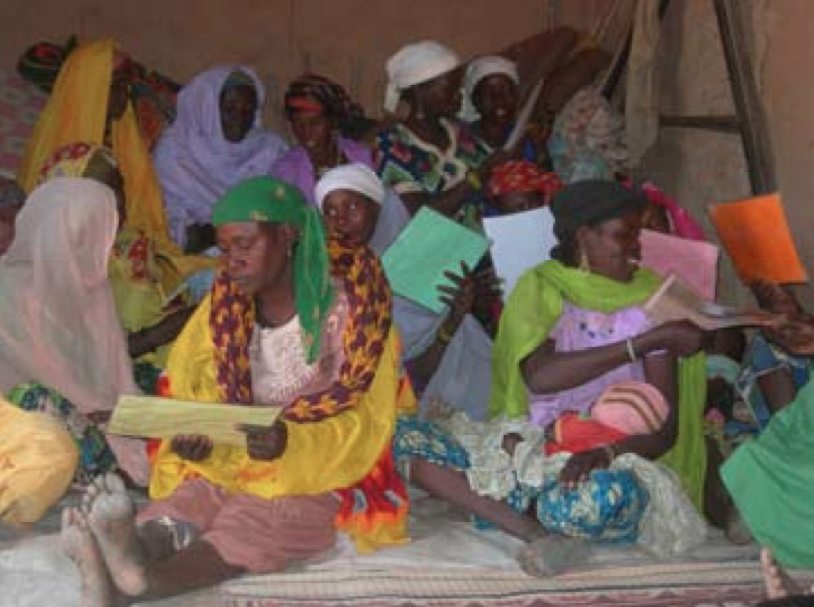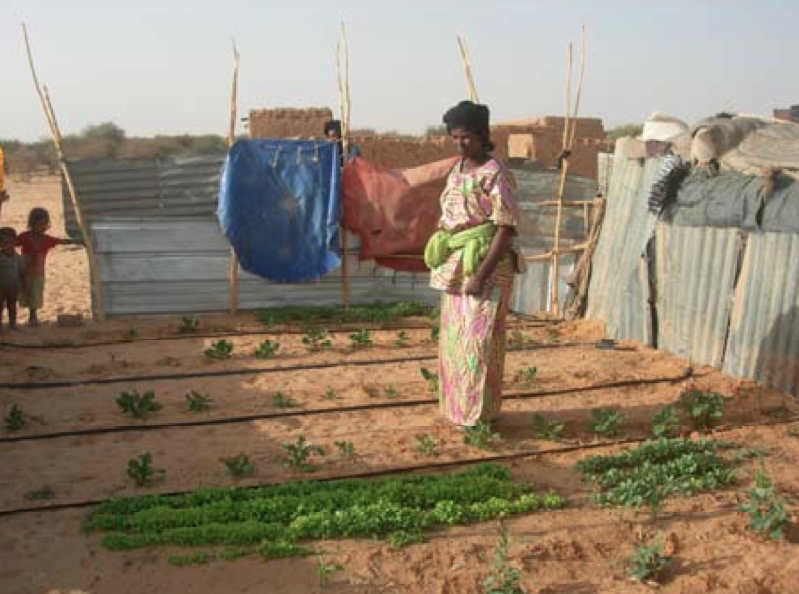CBA Niger: Adapting to Climate Change in the Community of Tamalolo
Project Overview
This Community-Based Adaptation project aimed to improve living conditions and the adaptive capacity of the rural communities of Tamalolo through the implementation of enhanced farming practices.
The predominant crops grown in the area are mil, sorghum, black-eyed peas, okra, and sorrel. Additionally, there is extensive breeding of goats, cattle, sheep, camels, donkeys and horses, and limited trading of goods, including sugar, doughnuts, condiments and cola. All of these activities are highly reliant on annual rainfall. The repeated droughts, extreme temperatures and violent winds affecting the region therefore make the communities of Tamalolo vulnerable to climate change impacts.
To help the communities adapt to the effects of climate change, this project intensified and diversified agro-silvo-pastoral production, mainly through the improvement of rainfall production systems and the introduction of drip irrigation. Project activities increased food security, decrease the animal losses, and erase the fodder deficit. Improved rain-fed farming techniques, well infrastructure, and irrigation technologies were introduced, along with a community awareness programme.
* This project was part of Niger's Community-Based Adaptation portfolio. *
Project Details
This Community-Based Adaptation project aims at improving living conditions and the adaptive capacity of the rural communities of Tamalolo (Niger) through the implementation of enhanced farming practices. The project site is in the Sahelo-Saharan zone of Niger, identified by the country’s National Adaptation Programme of Action (NAPA) as the most vulnerable area in the region to effects of climate change.
The project area encompasses 14 villages and tribes, with a population of approximately 2,216 residents—51 percent of whom are women. The communities’ principal socioeconomic activities are farming and breeding. Farming is rain-fed and practiced by all three ethnic groups. The predominant crops grown are mil, sorghum, black-eyed peas, okra, and sorrel. There is extensive breeding of goats, cattle, sheep, camels, donkeys and horses, and limited trading of goods, including sugar, doughnuts, condiments and cola.
All of the agricultural activities are highly reliant on annual rainfall. The repeated droughts, extreme temperatures and violent winds affecting the region make the communities of Tamalolo vulnerable. Food insecurity is high, access to water is scarce and all valued wildlife and vegetation species have disappeared and/or are now endangered. Ecosystems are also affected by these climate changes (soil degradation, rapid drying out of ponds, loss of woody and grassy vegetation species, disappearance of vegetation species, increased scarcity of young shoots). Water, which is increasing unavailable, is the key factor limiting development in Tamalolo. As the aridity in the area increases, agricultural production and the survival of the communities and animals reliant on water are significantly threatened.
Several climate change studies forecast an increase in average temperatures in Niger, growing precipitation variability, rising evapotranspiration and aridity. As described by the Nigerian NAPA, over the past decades the region has experienced several years of droughts, violent winds, extreme temperatures, dust storms, as well as grasshopper infestations and bush fires. In the long run, these climate risks are expected to increase. In addition, climate change will impact natural and agro-pastoral ecosystems, increase soil erosion and reduce the availability of water. This situation will augment production risks, and the survival of communities dependent on these natural resources will be jeopardized.
The most significant impact of climate change on the community is the decreased agro-silvo-pastoral production, causing chronic food insecurity, the loss of animals and a significant fodder deficit. To help the population adapt better to the effects of climate change, the project aims at intensifying and diversifying agro-silvo-pastoral production mainly through the improvement of rainfall production systems and the introduction of drip irrigation, which allow the local communities to increase the quality and quantity of their agricultural products, including mil, sorghum, and black-eyed peas. While the project was developed by CRAC-GRN, an NGO working in Niger since 1988, nearly 12 other NGOs and associations are also involved in the Tamalolo process. Project activities are implemented in a participative manner through the different management committees established, including community members, CRAC- GRN and authorities of the department and commune of Tanout.
To increase food security, decrease the loss of animals and fodder deficit, the project undertakes a variety of activities with community involvement. Simple water and soil preservation technologies will be developed and taught, and locally-appropriate agroforestry techniques introduced. Traditional wells will be improved and vulnerable groups (particularly women) will be equipped with low-cost drip irrigation. Zai, a half-moon and stone-line farming technique that restores degraded soils and improves biodiversity, will be introduced. Biological chords will be constructed to reduce the sand infiltration.
The project helps community members better understand climate change and the associated risks and impacts. It also aims at building the communities’ organizational capacities, with the prospect of sustaining the activities and ensuring the long-term viability of project. Together, these activities make the area more climate-resilient and decrease the community and ecosystem’s vulnerability to climate variability.
Key Results and Outputs
- Improve rain-fed farming activities (development of simple water and soil preservation technologies, improvement of the mechanism to acquire inputs, fighting against cultivation enemies, development of agroforestry).
- Construct two improved traditional wells and develop two old traditional wells. • Introduce low-cost drip irrigation aimed at vulnerable social groups, in particular women, structured around two truck farming sites of approximately one ha each.
- Introduce Zai, half-moon and stone-line farming techniques to use uncultivated land and restore degraded soils to improve biodiversity.
- Construct biological chords to reduce the sand covering of farmlands.
- Raise community awareness on the risks of climate change and teach adjustment strategies (purchase of awareness-raising materials, creation of communication tools, organization of screening sessions, etc.).
Reports and Publications
Brochures, Posters, Communications Products
Annual Reports
Project Brief / Fact Sheet
Monitoring and Evaluation
Monitoring and evaluation for community-based adaptation is a new field, and the CBA project is piloting innovative approaches to evaluating the success of locally-driven adaptation projects, and generating lessons to inform ongoing practice.
Key considerations in M&E for CBA include:
- Grounding M&E in the local context: M&E for CBA should avoid overly rigid frameworks, recognizing community heterogeneity and maintaining local relevance
- Capturing global lessons from local projects: CBA projects are highly contextualized, but lessons generated should be relevant to stakeholders globally
- Incorporation of both quantitative and qualitative indicators: to ground projects in tangible changes that can be objectively evaluated, and to capture lessons and case studies for global dissemination
To these ends, the CBA project uses three indicator systems: the Vulnerability Reduction Assessment, the Small Grants Programme Impact Assessment System, and the UNDP Climate Change Adaptation Indicator Framework.
The Vulnerability Reduction Assessment (VRA)
The VRA is a question-based approach with the following aims:
- To make M&E responsive to community priorities
- To use M&E to make projects more accountable to local priorities
- To make M&E capture community ideas and local knowledge
- To gather community-level feedback to guide ongoing project management
- To generate qualitative information
- To capture lessons on specific issues within community-based adaptation
- To generate case studies highlighting adaptation projects
The VRA follows UNDP's Adaptation Policy Framework, and is measured in a series of meetings with local community stakeholders. In these meetings, locally-tailored questions based on standard VRA questions/indicators are posed, and the community assigns a numerical score on a 1-10 scale for each question. Progress is evaluated through changes in scores over the course of implementation, as well as through qualitative data collected in community discussions surrounding the exercise.
UNDP has developed a Users Guide to the VRA (Espanol) (Francais) as a tool to assist practitioners to conceptualize and execute VRA measurements in the context of CBA projects.
The SGP Impact Assessment System (IAS)
The CBA, being a project of the GEF Strategic Priority on Adaptation, aims to increase the resilience of ecosystems and communities to the impacts of climate change, generating global environmental benefits, and increasing their resilience in the face of climate change impacts. To this end, the CBA projects use the SGP's impact assessment system for monitoring achievements in GEF focal areas (focusing primarily on biodiversity and sustainable land management).
The IAS is composed of a number of quantitative indicators which track biophysical ecosystem indicators, as well as policy impact, capacity development and awareness-building.
UNDP Climate Change Adaptation Indicator Framework
CBA projects also track quantitative indicators from UNDP's adaptation indicator framework, corresponding to the thematic area on natural resources management. More information on UNDP's indicator framework can be found on the UNDP climate change adaptation monitoring and evaluation website.
* This description applies to all projects implemented through UNDP's Community-Based Adaptation programme. Specific details on this project's M&E will be included here as they become available. *






